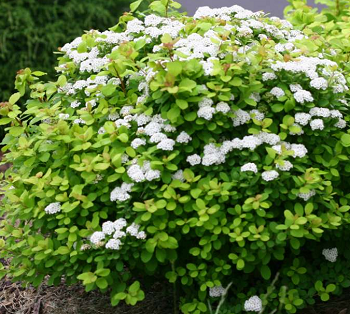The Birchleaf Spirea is an excellent choice for a compact, rounded shrub that can grow up to three or four feet in height. In the fall, the leaves transform into a kaleidoscope of colors, including red, orange, and purple, which contributes to the interest of the season. It can be placed in front of a border of shrubs or used in butterfly gardens.
Birchleaf spirea, also known as Spiraea betulifolia, is a plant that is native to Japan and other parts of eastern Asia. It is a small shrub that grows into a dense, round mound of leaves up to 3′ tall and as wide as it is fully grown. The leaves are birch-like, round to egg-shaped, and up to 2″ long, with toothed margins. In the middle of June, clusters of pure white blooms called corymbs cover the foliage. When fall arrives, the foliage takes on beautiful hues of orange, red, and purple.
Two natural subspecies of this plant are the eastern-growing Spiraea betulifolia var. corymbosa (shinyleaf meadowsweet) and the western-growing Spiraea betulifolia var. Lucida (shinyleaf spirea).
Birchleaf Spirea Growth Rate
Birchleaf spirea has a medium rate of growth and a maximum lifespan of 20 years. It’s a tiny shrub that grows to a height and width of around three to four feet and has a round, bushy appearance. The Birchleaf Spirea requires consistently damp circumstances for optimal growth and is not allowed to become completely dry. It is not concerned about the pH or type of soil. In the fall, the plant’s leaves transform into a rainbow of colors, including red, orange, and purple, which adds to the visual appeal of the season. Because Birchleaf spirea requires very little maintenance, it is an excellent choice for use in rock gardens and along walkways.
Birchleaf Spirea Bloom Time
Early summer is the blooming season for birchleaf spirea. In late spring and early summer, birch-like dark green leaves are covered in thin, flat clusters of tiny white flowers. It features birch-like leaves that are a deep green color.
The birchleaf spirea is more than just an ordinary garden plant. It is hardy, resistant to deer, requires little maintenance, and provides interest throughout all three seasons. Plants of the birchleaf spirea species can be propagated by taking hardwood cuttings in the spring or by dividing the bushes in the fall or spring. The buds get red and pink as they get bigger, and then they grow white flowers that last for weeks. It can also grow from its seeds.
Birchleaf Spirea Problems
Spirea is rarely affected by significant diseases or pests. Being members of the rose family, they are occasionally prone to the same pests and diseases as roses, including aphids, spider mites, and powdery mildew.
Pests and diseases rarely affect birchleaf spirea. On the other hand, it is susceptible to aphids, leaf rollers, powdery mildew, fire blight, root rot, and leaf spot, in addition to the scale and powdery mildew. The plant can also get infected with southern root-knot nematodes, which can make the leaves turn yellow or brown. The disease known as “fire blight” can result in dead leaves that hang down on the shrub.
Spirea plants also experience issues as a result of poor water management. Plants can experience stress from either an abundance or deficiency of water. Although spirea is tolerant of arid conditions, it thrives in constantly moist, well-drained soil. Putting mulch around the shrubs helps them, especially when it’s hot outside. Mulch with a thickness of two to three inches applied around bushes can reduce water loss through evaporation and preserve the plant’s roots from drying out.
Birchleaf Spirea Diseases
Birchleaf spirea is susceptible to fire blight and powdery mildew. Powdery mildew fungi attack spireas that grow in the shade and make white, powdery mats on their leaves. Insects or spring raindrops can transmit the bacteria that cause fire blight from cankers on previously diseased spirea branches to healthy tissue. They enter through open blooms, wind or insect damage, or natural entry points such as pores on the undersides of foliage. The disease causes the leaves to wither, fall to the ground, and cling to the blighted twigs. Throughout the summer, dying branches that have a burnt appearance are obvious and detract from the shrubs’ aesthetic value. Spirea can also be affected by aphid infestations, leaf spot infections, tar stains, mineral deficits, and nutrient excesses.



